Abstract
Parkinson’s disease (PD) is a neurodegenerative disorder caused by the loss of dopaminergic neurons, leading to the motor dysfunctions of patients. Although the etiology of PD is still unclear, the death of dopaminergic neurons during PD progress was revealed to be associated with the abnormal aggregation of α-synuclein, the elevation of oxidative stress, the dysfunction of mitochondrial functions, and the increase of neuroinflammation. However, current anti-PD therapies could only produce symptom-relieving effects, because they could not provide neuroprotective effects, stop or delay the degeneration of dopaminergic neurons. Marine-derived natural compounds, with their novel chemical structures and unique biological activities, may provide anti-PD neuroprotective effects. In this study, we have summarized anti-PD marine-derived natural products which have shown pharmacological activities by acting on various PD targets, such as α-synuclein, monoamine oxidase B, and reactive oxygen species. Moreover, marine-derived natural compounds currently evaluated in the clinical trials for the treatment of PD are also discussed.
1. Introduction
Parkinson’s disease (PD) is a common neurodegenerative disease that mainly occurs in the elderly [,]. The main pathological changes of PD included the progressive loss of dopaminergic (DA) neurons in the substantia nigra pars compacta (SNc), the decrease of dopamine content in the striatum, and the formation of α-synuclein aggregates in the brain []. The death of DA neurons in SNc could further inhibit thalamic activity, and reduce the excitatory input to the motor cortex, resulting in slow movements and limbs stiff in PD patients [].
Although the etiology of PD is still unclear, the death of DA neurons during PD progress was revealed to be associated with the abnormal aggregation of α-synuclein, the elevation of oxidative stress, the decrease of mitochondrial functions, and the increase of neuroinflammation []. Anti-PD drugs mainly aim to relieve motor and non-motor symptoms, and produce neuroprotective effects []. Clinically used anti-PD drugs include dopamine precursors (levodopa and carbidopa), dopamine agonists (pramipexole, ropinirole, rotigotine and apomorphine), catechol-O-methyl transferase (COMT) inhibitors and monoamine oxidase B (MAO-B) inhibitors (selegiline, rasagiline and safinamid) []. Levodopa is the first-line anti-PD drug used for relieving motor symptoms. As adjuvant therapies to levodopa, dopamine agonists are usually used in young PD patients. COMT inhibitors could increase the bioavailability of dopamine in the central nervous system (CNS) by reducing peripheral dopamine metabolism. MAO-B inhibitors can be used as a mono-therapy, or combined with t dopamine agonists or levodopa. However, these anti-PD drugs could relieve motor or non-motor symptoms, but could not produce neuroprotective effects. Therefore, the disease progress of PD could not be stopped or delayed by these drugs. Moreover, some anti-PD drugs could produce serious side effects. For example, levodopa could block aromatic amino acid decarboxylase, and cause nausea, vomiting, insomnia and nightmares. Long-term use of levodopa could lead to “on-off” phenomena, a switch between immobility and mobility in PD patients []. MAO-B inhibitors could increase synaptic availability of dopamine, and lead to nausea, insomnia, hallucinations and serotonergic crisis in combination with selective serotonin reuptake inhibitors []. Therefore, it is necessary to discover drugs that can effectively treat PD with neuroprotective effects and few side effects.
Marine-derived natural compounds could produce a variety of pharmacological effects, and are potentially highly useful for the development of new drugs []. 7 marine-derived natural compounds have been approved for clinical use []. Here, we have summarized marine-derived natural compounds with the effectiveness for the treatment of PD (Table 1). Moreover, marine compounds that have entered clinical trials against PD have also been discussed (Table 2).

Table 1.
Marine natural products (1–29) with anti-PD activities, and their mode of actions.

Table 2.
Marine-derived natural products (30–34) used in clinical trials against PD (Data sources: ClinicalTrials.gov).
2. The Therapeutic Targets of PD
Many targets, including the abnormal aggregation of α-synuclein, MAO-B, neurotrophic factors, and reactive oxygen species (ROS) have crucial impacts on the progress of PD.
2.1. α-Synuclein Aggregates
The aggregation of α-synuclein is associated with neurotoxicity in the brain, leading to the progressive loss of DA neurons during PD progress. Therefore, abnormal α-synuclein aggregation has been intensively considered as a main therapeutic target for PD []. Moreover, Lewy bodies, protein inclusion bodies contain mainly aggregated α-synuclein, are presented in the pre-synaptic neurons []. Accumulation of α-synuclein aggregation could be produced either by the excessive aggregation of α-synuclein or by the incapable clearance of aggregated α-synuclein []. Abnormal aggregates of α-synuclein, such as oligomers or fibrils, may interfere with cell processes, leading to the diffusion of α-synuclein aggregates between neurons []. It has been shown that wild-type mice treated with aggregates of α-synuclein in the striatum could cause the intracellular transmission of α-synuclein in the whole brain. Moreover, the administration of α-synuclein aggregates results in the loss of DA neurons in SNc, the decrease of dopamine levels in the striatum, and eventually the motor deficits in PD []. Although it is not clear how α-synuclein aggregates cause neuronal toxicity, there is evidence that α-synuclein aggregates may disrupt protein degradation systems and mitochondrial functions []. Therefore, inhibiting the expression and aggregation of α-synuclein or increasing the clearance rate of aggregated α-synuclein may be an important strategy for the treatment of PD [].
2.2. MAO-B
MAO-B mainly located in the outer membrane of mitochondria []. Unlike monoamine oxidase-A (MAO-A), which is involved in the metabolism of serotonin, norepinephrine and dopamine, MAO-B is specialized to metabolize dopamine neurotransmitters, and produces ROS that directly damages DA neurons []. Therefore, MAO-B inhibitors could elevate the concentration of synaptic dopamine by blocking the degradation of dopamine, and eventually produce neuroprotective effects []. For example, selegiline, an irreversible MAO-B inhibitor, could produce neuroprotective effects in vitro []. Rasagiline, another MAO-B inhibitor, could be used to prevent the symptoms of idiopathic PD []. In animals, selegiline and rasagiline could prevent 1-methyl-4-phenyl-1,2,3,6-tetrahydropyridine (MPTP)-induced toxicity to DA neurons through the inhibition of neurotoxicity produced by 1-methyl-4-phenyl-pyridinium (MPP+), an MPTP metabolite []. Therefore, novel MAO-B inhibitors have been extensively studied for treating PD [].
2.3. Neurotrophic Factors
Neurotrophic factors could promote the survival of neurons, and therefore be served as potential therapeutic agents for the treatment of PD []. It has been found that the glial cell-derived neurotrophic factor (GDNF) could enhance the differentiation and survival of DA neurons, producing anti-PD neuroprotective activity []. Moreover, other neurotrophic factors, such as neurturin, could protect and regenerate DA neurons []. Recent studies have shown that SKF38393, a D1 receptor selective agonist, could improve the growth of DA neurons by increasing the expression of brain-derived neurotrophic factor (BDNF) in neuronal cultures []. Moreover, natural compound PYM50028 could lead to a significant increase in GDNF and BDNF, reducing MPTP-induced loss of DA neurons in mice []. These studies support the idea that neurotrophic factors have therapeutic potential by preventing DA neuronal damage during PD progress, and drugs that could elevate the expression of neurotrophic factors might be used in the treatment of PD.
2.4. ROS
DA is not only a physiological neurotransmitter, but also a main source of ROS. DA contains an unstable catechol moiety, which can oxidize to form ROS [,]. In addition, the oxidation products of DA could be polymerized to form neuromelanin, a highly cytotoxic substance []. Many neurotoxins, such as MPTP, 6-hydroxydopamine (6-OHDA) and paraquat (PQ) could induce the elevation of ROS, and lead to similar pathological and biochemical symptoms as PD in humans []. Therefore, these neurotoxins are commonly used to establish PD animal models.
Many endogenous proteins could produce antioxidant activities. For example, DJ-1, a conserved protein involving in neurodegeneration, could produce neuroprotective effects against oxidative stress via activating the extracellular signal-regulated kinase (ERK) pathway []. Moreover, hydrogen peroxide (H2O2)-induced neurotoxicity is inhibited by a pro-survival phosphoinositide 3-kinase (PI3-K)/Akt pathway []. The transcription factor nuclear factor-erythroid 2-related factor 2 (Nrf2) could regulate the transcription of endogenous protective proteins, and protect against neuroinflammatory and oxidative stresses []. The Nrf2/antioxidant responsive element (ARE) cascade can be further involved in the maintenance of mitochondrial homeostasis []. Voltage-dependent anion-selective channel 1 (VDAC1) is located in the outer membrane of mitochondria. ROS produced by mitochondrial complex III could be released into the cytosol from VDAC1 []. In the brain of PD patients, VDAC1 could also increase the concentrations of Ca2+ in the mitochondria, leading to the increase of mitochondrial permeability, the disruption of mitochondrial membrane potential, and eventually to neuronal apoptosis and degeneration []. Therefore, neuroprotective agents that could elevate anti-oxidative stress via acting on VDAC1, ERK, PI3-K/Akt and Nrf2/ARE cascades might produce anti-PD activities.
To date, PD is a complex disease with multiple pathological factors. Therefore, the effects of multiple factors coordination in PD progress should not be negligible. Multi-target drugs could simultaneously act on two or more anti-PD targets, and might produce greater therapeutic potential than single-target drugs for treating PD.
3. Potential Candidates from Marine-Derived Compounds for the Treatment of PD
3.1. Archaea
Many hyperthermophiles could release zwitterionic natural products in extreme environments such as high temperature and osmotic pressure to prevent thermal denaturation and aggregation of proteins []. Such natural products may be used to inhibit abnormal α-synuclein aggregation. Mannosylglycerate (MG) (1) is a compatible solute produced by hyperthermophilic bacteria in the hot environment (Figure 1). MG could inhibit the formation of α-synuclein aggregates in a PD yeast model. Moreover, MG could promote the folding of α-synuclein, preventing the pathological aggregation of α-synuclein []. Therefore, MG represents a good candidate for the treatment of PD.
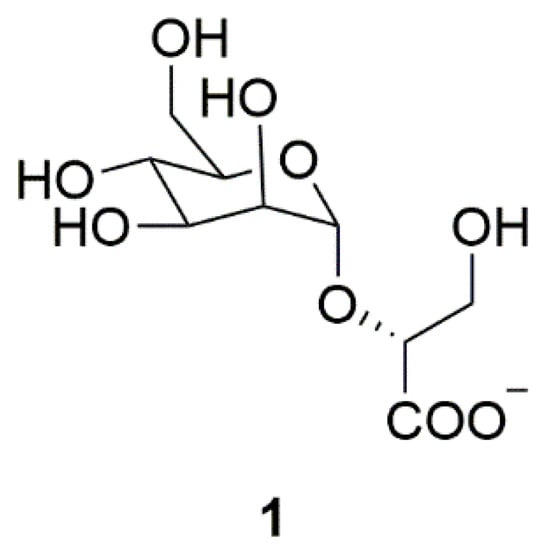
Figure 1.
Marine natural product mannosylglycerate (MG) (1) derived from archaea.
3.2. Bacteria
Secondary metabolites from marine-derived bacteria represent a rich source for drug development with novel chemical structures and diverse biological activities [,]. NP7 (2) is a marine-derived compound from Streptomyces sp (Figure 2). NP7 is an antioxidant, and could pass the blood-brain barrier. NP7 at 5–10 μM could prevent apoptosis and necrosis induced by H2O2 in neurons and glial cells []. In addition, NP7 could inhibit microglial activation, and prevented the increased phosphorylation of ERK induced by H2O2. Therefore, NP7 may be developed as a neuroprotective agent against oxidative stress in PD [,].
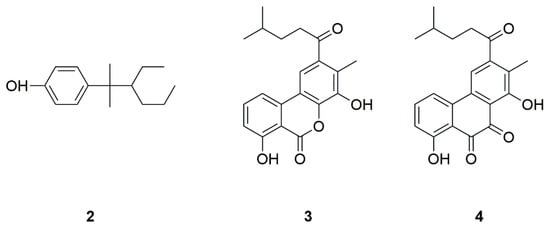
Figure 2.
Marine natural products NP7 (2), piloquinone A (3) and piloquinone B (4) derived from bacteria.
The inhibitory activity of piloquinones, marine-derived compounds isolated from Streptomyces sp., on MAO-B was reported []. Piloquinone A (3) and piloquinone B (4) were isolated from Streptomyces sp. CNQ-027 (Figure 2) []. Piloquinone (A) is a potent inhibitor of MAO, with an IC50 value of 1.21 μM for MAO-B and an IC50 value of 6.47 μM for MAO-A, respectively. At the same condition, piloquinone (B) is only effective against MAO-B, with an IC50 value of 14.50 µM []. These results indicated that piloquinone derivatives may be useful lead compounds in the development of MAO-B inhibitors for the treatment of PD.
3.3. Fungi
There are many marine fungal metabolites could produce anti-PD neuroprotective activities. Neoechinulin A (5) is a diketopiperazine alkaloid of isoprene quinone isolated from the red algae-related fungus Microsporum sp. and Aspergillus sp. (Figure 3) []. Neoechinulin A could protect PC12 cells against MPP+- and peroxynitrite-induced neuronal death via reversing mitochondrial complex I dysfunction [,]. Moreover, Neoechinulin A could prevent rotenone-induced neurotoxicity by activating mitochondrial-related cytoprotective mechanisms []. Therefore, neoechinulin A may have the potential to interfere with progressive DA degeneration of PD.
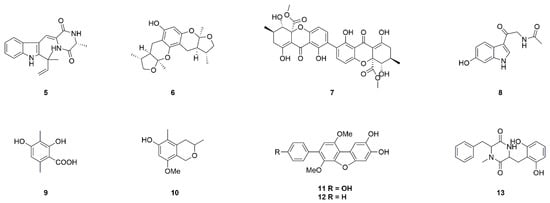
Figure 3.
Marine natural products neoechinulin A (5), xyloketal B (6), secalonic acid A (7), 6-hydroxy-N-acetyl-β-oxotryptamine (8), 3-methylorsellinic acid (9) and 8-methoxy-3,5-dimethylisochroman-6-ol (10), candidusin A (11), 4-dehydroxycandidusin A (12) and diketopiperazine mactanamide (13) derived from fungi.
Xyloketal B (6) belongs to a series of new ketal compounds isolated from the mangrove fungus Xylaria sp. (Figure 3) []. Xyloketal B could scavenge di(phenyl)-(2,4,6-trinitrophenyl)imino-nitrogen (DPPH) free radicals, and protect PC12 cells against ischemia-induced neurotoxicity []. Moreover, the neuroprotective effects of xyloketal B may be due to the inhibition of NADPH oxidase-derived ROS production []. However, the effects of xyloketal B on the prevention of MPP+-induced neurotoxicity are only moderate. Therefore, 39 new xyloketal derivatives were synthesized to screen drug candidates for the treatment of PD [].
Secalonic acid A (7) is a natural product obtained from marine fungus Aspergillus ochraceus and Paecilomyces sp. (Figure 3) []. Secalonic acid A at 3–10 μM significantly inhibited colchicine-induced apoptosis of cortical neurons by the inhibition of JNK and p38 phosphorylation, and the reduction of Ca2+ influx and caspase-3 activation []. Secalonic acid A could also protect DA neurons against MPTP/ MPP+ by reversing mitochondrial apoptotic pathways [].
Melatonin analog 6-hydroxy-N-acetyl-β-oxotryptamine (8), 3-methylorsellinic acid (9) and 8-methoxy-3,5-dimethylisochroman-6-ol (10) were isolated from marine fungus Penicillium sp (Figure 3). KMM 4672. These compounds could produce neuroprotective activity against 6-OHDA- and PQ-induced neuronal toxicity [,]. Similarly, candidusin A (11) and 4-dehydroxycandidusin A (12) from Aspergillus sp. KMM 4676, and diketopiperazine mactanamide (13) from Aspergillus flocculosus, can protect Neuro2A cells from the toxicity effects of 6-OHDA via scavenging ROS (Figure 3) [,,]. These results suggested that such compounds may be used to develop anti-PD leads.
3.4. Algae
Marine algae are a rich source of antioxidants []. Carotenoids, particularly astaxanthin (14) derived from marine microorganisms (algae such as Haematococcus pluvialis and Chlorella zofingiensis), is proven to be an effective adjuvant therapy for preventing and/or delaying the progression of neurodegenerative diseases (Figure 4) [,]. The unique chemical structure of astaxanthin allowed it to easily cross the blood-brain barrier []. Moreover, astaxanthin could produce anti-PD effects in mice []. It was demonstrated that astaxanthin could reduce the activation of microglia in the brain of mice []. Astaxanthin could also inhibit neuronal apoptosis and mitochondrial abnormalities, and reduce intracellular ROS [,]. In addition, synthetic astaxanthin is superior to algae-extracted astaxanthin in terms of anti-inflammatory and anti-oxidant properties, leading to astaxanthin that is convenient and promising for the treatment of PD [].
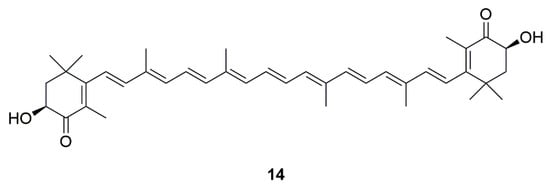
Figure 4.
Marine natural product astaxanthin (14) derived from algae.
Algae polysaccharides are effective free radical scavengers and antioxidants in vitro []. Fucoidan (15), a representative algae polysaccharide, could prevent MPTP-induced neurotoxicity via its antioxidant and anti-apoptotic abilities []. Moreover, fucoidan could inhibit lipopolysaccharide (LPS)-induced nitric oxide (NO) production in microglia. The underlying mechanisms of these effects may include the down-regulation of intracellular ROS and pro-inflammatory cytokines [,].
Brown algae could produce a variety of fucoidan. The polysaccharide fucoidan is one of the main sulfated polysaccharides extracted from Turbinaria decurrens [,]. Mice treated with polysaccharide fucoidan could prevent MPTP-treated behavioral abnormities, possibly by increasing tyrosine hydroxylase (TH) levels in the substantia nigra and striatum []. These results indicated that polysaccharide fucoidan may produce neuroprotective effects against PD.
Sulfated hetero-polysaccharides (DF1) (16) and sulfated galactofucan polysaccharides (DF2) (17), another two fucoidan derived from brown seaweed Laminaria japonica, also possess neuroprotective activities []. The antioxidant activity of sulfated polysaccharides depends on their molecular weight, types of glucose and glycosidic branching []. DF1 and DF2 could significantly increase the number of DA neurons in MPTP-induced mice []. Moreover, DF1 and DF2 could reverse MPP+-induced decrease of mitochondrial activity []. DF1 has a more complex chemical composition, and shows the greater neuroprotective activity than DF2 []. In addition, DF1 could protect SH-SY5Y cells against H2O2-induced apoptosis by activating the nerve growth factor (NGF) /PI3-K/Akt signaling pathway [].
Spirulina platensis (18) is a multicellular filamentous cyanobacterium with high levels of protein and a large amount of essential fatty acids []. Spirulina platensis protein extract and phycocyanin could exert antioxidant activity by elevating the activity of cellular antioxidant enzymes, indicating that Spirulina platensis is a powerful antioxidant that interferes with free radical-mediated cell death through mechanisms associated with antioxidant activity. The enhanced diet by Spirulina platensis could provide neuroprotection in α-synuclein-induced neurotoxicity model of PD []. Moreover, Spirulina polysaccharides could produce protective effects against MPTP- and 6-OHDA-induced loss of DA in mice [,].
Fucoxanthin (19) is a marine carotenoid extracted from edible brown algae, and was reported to have anti-oxidant and anti-inflammatory activity (Figure 5) []. Recently, fucoxanthin was found to produce neuroprective effects through multiple targets. Fucoxanthin could attenuate neurotoxicity induced by H2O2 via activating the PI3-K/Akt cascade and inhibiting the ERK pathway []. These reults suggested that fucoxanthin may play a role in the treatment of PD.

Figure 5.
Marine natural product Fucoxanthin (19) derived from edible brown algae.
3.5. Sponge
Marine sponges are a rich source of bioactive chemicals [,]. Gracilins (A, H, K, J and L) (20) and tetrahydroaplysulphurin-1 (21) are a group of diterpene derivatives isolated from Spongionella sp., acting on tyrosine kinases (Figure 6) []. Both gracilins and tetrahydroaplysulphurin-1 could protect cortical neurons against oxidative damage by activating the Nrf2/ARE pathway, indicating that these metabolites may be interesting candidates for neurodegenerative diseases [].
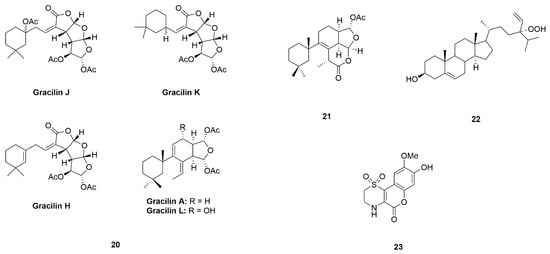
Figure 6.
Marine natural products Gracilins (A, H, K, J and L) (20), tetrahydroaplysulphurin-1 (21), 24-hydroperoxy-24-vinylcholesterol (22), and iotrochotazine A (23), derived from sponge.
24-hydroperoxy-24-vinylcholesterol (22) is isolated from sponge Xestospongia testudinaria (Figure 6) []. 24-hydroperoxy-24-vinylcholesterol is an unusual oxidative steroid containing a hydroperoxy group in the branch. It has shown that the activation to nuclear factor kappa B (NF-κB) with an IC50 value at 31.3 μg/mL, suggesting that it might be useful for PD therapy [].
Iotrochotazine A (23), contains a 1,1-dioxo-1,4-thiazine ring and a coumarin backbone, representing a novel structural class of marine alkaloid (Figure 6). Iotrochotazine A is extracted from Iotrochota sp. []. Iotrochotazine A could specifically affect the morphology and cellular distribution of lysosomes and early endosomes in olfactory neurosphere-derived cells from idiopathic PD patients, suggesting that iotrochotazine A may be developed as a novel anti-PD lead [,].
Mirabamides A-H peptide (24) is a group of marine peptides from the sponges Siliquariaspongia mirabilis and Stelletta clavosa [,]. It have been reported that elevated advanced glycation endproducts (AGEs) could induce the abnormal aggregation of α-synuclein []. Mirabamides A-H peptides could preferably inhibit pyridoxamine-based AGEs, and therefore might be developed as anti-PD candidates [].
3.6. Coral
Marine-derived compound 11-dehydrosinulariolide (25) was extracted from soft coral Sinularia flexibili (Figure 7) []. 11-dehydrosinulariolide could up-regulate the PI3-K/Akt pathway to protect DA neurons against 6-OHDA-mediated damage []. Moreover, 11-dehydrosinulariolide-induced up-regulation of DJ-1 protein expression was revealed by 2D gel electrophoresis []. Furthermore, 11-dehydrosinulariolide could attenuate the damage of DA neurons in 6-OHDA-induced zebrafish and rats []. These results suggested that 11-dehydrosinulariolide can exert neuroprotective effects in PD models.
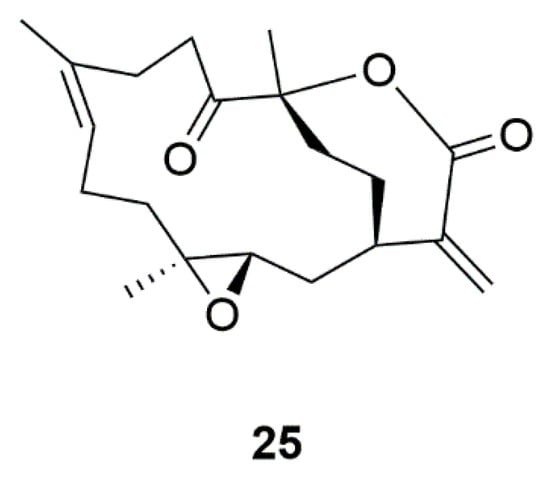
Figure 7.
Marine natural product 11-dehydrosinulariolide (25) derived from coral.
3.7. Mollusk
Staurosporine (AM-2282) (26) is a kinase inhibitor originally isolated from the actinomycete Streptomyces staurosporeus (Figure 8) []. Staurosporine (AM-2282) could also be found in marine sea squirt and flatworm []. By activating AMP-activated protein kinase (AMPK)/mammalian target of rapamycin (mTOR) signaling pathway, staurosporine (AM-2282) at 10 nM could induce DA neurite outgrowth in mesencephalic primary cultures []. Moreover, staurosporine (AM-2282) could protect neurons against ischemic-induced toxicity []. However, staurosporine is very toxic. Therefore, staurosporine analogues have been developed from structural modification with the aim of reducing toxicity [].
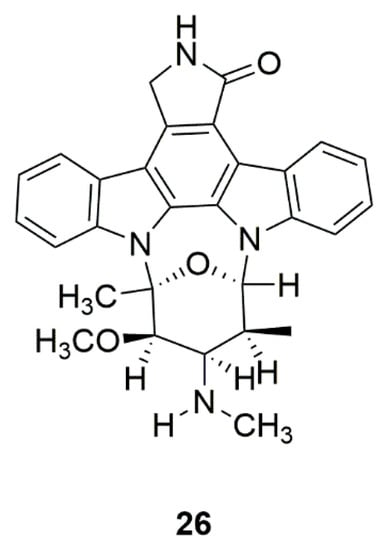
Figure 8.
Marine natural product staurosporine (AM-2282) (26) derived from prosobranch mollusk, flatworm, and ascidians.
3.8. Sea Cucumber
Sea cucumber is a marine invertebrate that contains valuable ingredients. In many Eastern counties, sea cucumber is recognized as a tonic and traditional therapy for neurodegenerative disorders. Whole body-ethyl acetate (WBEA), whole body-butanol (WBBU), and body wall-ethyl acetate (BWEA) (27) are extracts of sea cucumber Holothuria scabra. These compounds could significantly attenuate the degeneration of DA neurons induced by 6-OHDA in caenorhabditis elegans []. Moreover, these extracts could inhibit abnormal aggregation of α-synuclein, and restore lipid content [].
The sea cucumber extract glucocerebrosides (SCG-1, SCG-2, and SCG-3) (28) from Cucumaria frondosa are important sphingolipids (Figure 9) []. SCG-1, SCG-2, and SCG-3 could promote neurite outgrowth in NGF-induced PC12 cells in a dose-dependent and structure-selective manners, possibly via enhancing NGF-induced TrkA phosphorylation and increasing BDNF expression []. These results suggested that sea cucumber extracts and its active ingredient compounds may have anti-PD potential.

Figure 9.
Marine natural product glucocerebrosides (SCG-1, SCG-2, and SCG-3) (28) derived from Cucumaria frondosa.
3.9. Conus
Nicotine acetylcholine receptors (nAChRs) could regulate dopamine release, and are regarded as important target of PD []. Many marine organisms could produce toxins that selectively target nAChRs. α-conotoxin (TxIB) (29) derived from Conus textile is a 16 amino acid peptide (Figure 10). α-conotoxin could block α6/α3β2β3 nAChR with an IC50 value of 28 nM, indicating that α-conotoxin may be a potential candidate against PD [].

Figure 10.
α-Conotoxin (TxIB) (29) derived from Conus textile.
4. Marine-Derived Drugs for Clinical Trials of PD
4.1. Omega-3 Fatty Acids (30)
The consumption of marine fish and seafood has been associated with mental health. Most of neurological benefits provided by seafood consumption is believed from an adequate uptake of omega-3 fatty acids (n-3/PUFAs) []. In the CNS, cell membranes of neurons contain (n-3)/PUFAs such as docosahexaenoic acid (DHA) and eicosapentaenoic acid (EPA) []. Omega-3 fatty acids are mainly contained in deep-sea oily fish, as well as algae []. Omega-3 fatty acids are used as a therapy in 1356 clinical trials, including 2 clinical trials related to PD. In a double-blind, randomized, placebo-controlled clinical trial, 29 PD patients receiving omega-3 fatty acid supplements completed a 12-week trial. The results showed that PD patients taking fish oil and antidepressants largely relieved depressive symptoms, suggesting that omega-3 fatty acid supplements are safe to PD patients, and may be used as an adjunct to other drugs []. In another double-blind, randomized, placebo-controlled clinical trial, after taking omega-3 fatty acids and vitamin E, 60 PD patients have beneficial effects at the unified PD rating stage [].
4.2. Inosine (31)
Inosine, a precursor of uric acid, can be isolated from sponges (Figure 11) []. As an important physiological antioxidant, uric acid has been identified as a molecular predictor associated with a reduction in PD risk and a potential neuroprotective agent for PD []. In the clinical trial, inosine was generally safe, tolerable and effective in raising serum and cerebrospinal fluid urate levels in PD patients. These findings support further development of inosine as a potential disease-modifying therapy for PD [].
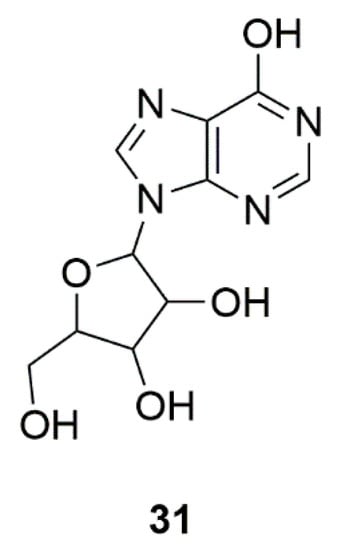
Figure 11.
Sponge-derived compound Inosine (31).
4.3. Pramipexole (32)
Pramipexole is a dopamine agonist, and could be used in the treatment of PD (Figure 12). Marine yeast in deep seabed sediments can be used as a biocatalyst for stereo-selective reduction of different ketones and biotransformation in seawater, and could be used to produce pramipexole []. The NIH database showed that there are 79 clinical trials of pramipexoleon on PD. Particularly, improved depressive symptoms were observed in PD patients using pramipexoleon [].
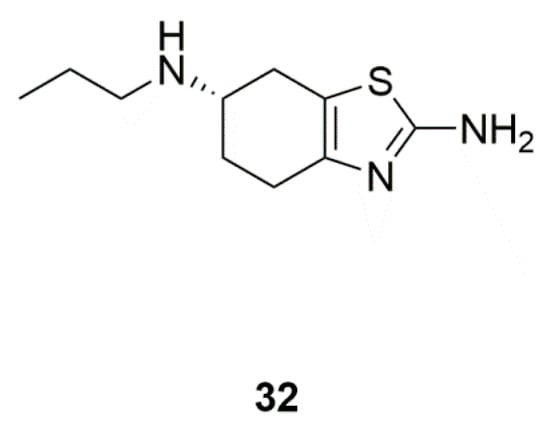
Figure 12.
Pramipexole (32) could be synthesized with the help of marine yeast.
4.4. CEP-1347 (KT7515) (33)
CEP-1347, a semisynthetic indolocarbazole derivative isolated from naturally occurring Nocardiopsis sp. K252a (Figure 13) []. CEP-1347 could inhibit the SAPK/JNK pathway, which is activated after a variety of neuronal toxic insults in neurons []. Moreover, CEP-1347 is a potent inhibitor of mixed lineage kinase (MLK), and could be used to treat HIV-associated cognitive disorders by binding to ATP site of MLK []. However, CEP-1347 did not show effective therapeutic effects in early PD patients in a double-blinded, randomized, placebo-controlled clinical trial [].
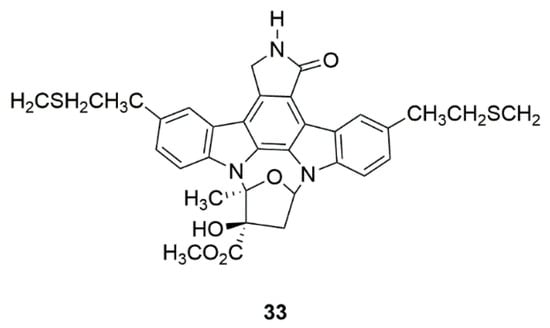
Figure 13.
Marine natural product CEP-1347 (33) isolated from Nocardiopsis sp. K252a.
4.5. GM1 ganglioside (34)
GM1 ganglioside has been suggested as a disease-modifying treatment for PD (Figure 14) []. Monosialoganglioside GM1 can be prepared using a sialidase-producing marine bacterium as a microbial biocatalyst []. PD patients taking GM1 ganglioside showed early improvements of symptom and slow progression of symptoms. The results of the imaging studies provided additional data demonstrating the potential disease-modifying effects of GM1 on PD []. At another clinical trial, PD patients taking GM1 ganglioside showed a significant improvements in motor scores []. It is speculated that GM1 ganglioside may modulate lipid raft structure and function to exert neuroprotective activities. However, the detailed mechanism of neuroprotective effects of GM1 ganglioside is still uncertain.
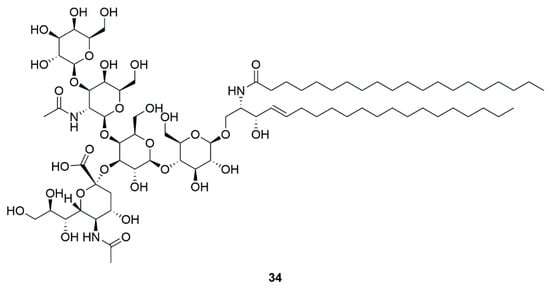
Figure 14.
GM1 ganglioside (34) can be prepared using a sialidase-producing marine bacterium as a microbial biocatalyst.
5. Conclusions
Currently, there is no effective pharmacological treatment for blocking or slowing PD process. As aging continues to increase, the incidence of PD and explosive mortality of PD patients are increasing dramatically. Therefore, the discovery and development of new anti-PD drugs should not be delayed.
PD is a complex disease with many pathological factors. Therefore, it is possible to discover drugs that work synergistically with multiple targets of PD. Most clinically used anti-PD drugs are produced by acting on a single target with a certain degree of side effects. Marine-derived compounds usually contain reactive groups such as -OH, -NH2, and –SH in their chemical structures, and might be act as anti-oxidants. Other functional groups of marine-derived compounds might enable them to act on anti-PD targets such as α-synuclein, MAO-B and other key proteins in the signaling pathways. Therefore, marine-derived compounds, e.g., 7, 14, 16, 17, 18, 25, 26, 27, 28 in this review, might be developed as anti-PD leads with multiple targets.
Many clinical trials on PD aim to improve the efficacy of drugs already used in the treatment of PD. This is partially because of the difficulty of finding novel natural compounds from terrestrial organisms. The sea is a treasure for discovering novel natural compounds. Marine-derived compounds have continuously entered into clinical trials against different diseases, and have become one of the important sources of drug development []. Recently, the anti-AD marine-a GV-971 has successfully passed phase III clinical trial in China, and has gradually advanced in the process of drug application, indicating that marine-derived compounds could be used to treat neurodegenerative disorders. Some marine-derived compounds, e.g., 30–34 in this review, have entered clinical trials with the aim of treating PD, further providing a support that novel anti-PD drugs might be developed from marine-derived compounds.
With the increasing exploration of the ocean, more marine drugs have been emerged. However, we have only touched the tip of the iceberg for marine resources. Marine organisms could produce a large number of chemicals with novel structures and diverse activities. In addition to compounds that are directly extracted or isolated from marine organisms, designed compounds could be modified and synthesized from the marine-derived leads.
In this review, 34 marine-derived compounds with pharmacological potential on PD therapy have been summarized, among which 5 compounds have entered into anti-PD clinical trials. Through high-throughput screening and combinatorial chemistry applications, more drug candidates will be found from the marine natural product library for the treatments of PD, especially those could be synthesized directly, or could be obtained in large quantities by fermentation or culture. We anticipated that further focusing on natural products from marine sources may be a promising idea for developing anti-PD leads.
Author Contributions
Writing—original draft preparation, C.H. and W.C.; Writing—review and editing, Z.Z. and W.C.
Funding
This research was funded by the National Natural Science Foundation of China (81870853), Ningbo Sci & Tech Project for Common Wealth (2017C50042), Zhejiang Key Laboratory of Pathophysiology (201804), Open Project Program of State Key Laboratory of Food Nutrition and Safety, Tianjin University of Science & Technology (SKLFNS-KF-201806), Ningbo municipal innovation team of life science and health (2015C110026), LiDakSum Marine Biopharmaceutical Development Fund, and the K. C. Wong Magna Fund in Ningbo University.
Conflicts of Interest
The authors declare no conflict of interest.
References
- Findley, L.; Aujla, M.; Bain, P.G.; Baker, M.; Beech, C.; Bowman, C.; Holmes, J.; Kingdom, W.K.; MacMahon, D.G.; Peto, V.; et al. Direct economic impact of Parkinson’s disease: A research survey in the United Kingdom. Mov. Disord. 2003, 18, 1139–1145. [Google Scholar] [CrossRef]
- Opara, J.; Malecki, A.; Malecka, E.; Socha, T. Motor assessment in Parkinson’s disease. Ann. Agric. Environ. Med. 2017, 24, 411–415. [Google Scholar] [PubMed]
- Charan, A.A.; Sinha, P.R. Parkinson’s disease: A review article. Pharma Innov. J. 2017, 6, 511–513. [Google Scholar]
- Dauer, W.; Przedborski, S. Parkinson’s Disease: Mechanisms and Models. Neuron 2003, 39, 889–909. [Google Scholar] [CrossRef]
- Dexter, D.T.; Jenner, P. Parkinson disease: From pathology to molecular disease mechanisms. Free Radic. Biol. Med. 2013, 62, 132–144. [Google Scholar] [CrossRef]
- Charvin, D.; Medori, R.; Hauser, R.A.; Rascol, O. Therapeutic strategies for Parkinson disease: Beyond dopaminergic drugs. Nat. Rev. Drug Discov. 2018, 17, 804–822. [Google Scholar] [CrossRef] [PubMed]
- Homayoun, H. Parkinson Disease. Ann. Intern. Med. 2018, 169, ITC33–ITC48. [Google Scholar] [CrossRef]
- Young, B.K.; Camicioli, R.; Ganzini, L. Neuropsychiatric Adverse Effects of Antiparkinsonian Drugs. Drugs Aging 1997, 10, 367–383. [Google Scholar] [CrossRef]
- Corona, J.C. Natural Compounds for the Management of Parkinson’s Disease and Attention-Deficit/Hyperactivity Disorder. BioMed Res. Int. 2018, 2018, 4067597. [Google Scholar] [CrossRef] [PubMed]
- Gerwick, W.H.; Moore, B.S. Lessons from the Past and Charting the Future of Marine Natural Products Drug Discovery and Chemical Biology. Chem. Biol. 2012, 19, 85–98. [Google Scholar] [CrossRef] [PubMed]
- Faria, C.; Jorge, C.D.; Borges, N.; Tenreiro, S.; Outeiro, T.F.; Santos, H. Inhibition of formation of α-synuclein inclusions by mannosylglycerate in a yeast model of Parkinson’s disease. Biochim. Biophys. Acta 2013, 1830, 4065–4072. [Google Scholar] [CrossRef] [PubMed]
- García-Palomero, E.; Usán, P.; Pérez-Baz, J.; Fernández, R.I.; Martínez, A.; Fernández, A.; Medina, M. Therapeutic Potential of Potent Marine Neuroprotectants. In New Trends in Alzheimer and Parkinson Related Disorders: ADPD; Hanin, I., Windisch, M., Poewe, W., Fisher, A., Eds.; Medimond S.R.L-Monduzzi Editore International Proceedings Division: Salzburg, Austria, 2007; pp. 289–294. [Google Scholar]
- Mena, M.A.; Casarejos, M.J.; Solano, R.; Rodríguez-Navarro, J.A.; Gómez, A.; Rodal, I.; Medina, M.; de Yebenes, J.G. NP7 protects from cell death induced by oxidative stress in neuronal and glial midbrain cultures from parkin null mice. FEBS Lett. 2009, 583, 168–174. [Google Scholar] [CrossRef] [PubMed]
- Koppula, S.; Kumar, H.; More, S.V.; Kim, B.W.; Kim, I.S.; Choi, D.K. Recent advances on the neuroprotective potential of antioxidants in experimental models of Parkinson’s disease. Int. J. Mol. Sci. 2012, 13, 10608–10629. [Google Scholar] [CrossRef]
- Nam, S.J.; Kauffman, C.A.; Jensen, P.R.; Fenical, W. Isolation and Characterization of Actinoramides A-C, Highly Modified Peptides from a Marine Streptomyces sp. Tetrahedron 2011, 67, 6707–6712. [Google Scholar] [CrossRef] [PubMed]
- Lee, H.W.; Choi, H.; Nam, S.J.; Fenical, W.; Kim, H. Potent Inhibition of Monoamine Oxidase B by a Piloquinone from Marine-Derived Streptomyces sp. CNQ-027. J. Microbiol. Biotechnol. 2017, 27, 785–790. [Google Scholar] [CrossRef] [PubMed]
- Li, Y.; Li, X.; Kang, J.S.; Choi, H.D.; Son, B.W. New Radical Scavenging and Ultraviolet-A Protecting Prenylated Dioxopiperazine Alkaloid Related to Isoechinulin A from a Marine Isolate of the Fungus Aspergillus. J. Antibiot. 2004, 57, 337–340. [Google Scholar] [CrossRef]
- Kimoto, K.; Aoki, T.; Shibata, Y.; Kamisuki, S.; Sugawara, F.; Kuramochi, K.; Nakazaki, A.; Kobayashi, S.; Kuroiwa, K.; Watanabe, N.; et al. Structure-activity Relationships of Neoechinulin A Analogues with Cytoprotection against Peroxynitrite-induced PC12 Cell Death. J. Antibiot. 2007, 60, 614–621. [Google Scholar] [CrossRef] [PubMed]
- Kajimura, Y.; Aoki, T.; Kuramochi, K.; Kobayashi, S.; Sugawara, F.; Watanabe, N.; Arai, T. Neoechinulin A Protects PC12 Cells against MPP+-induced Cytotoxicity. J. Antibiot. 2008, 61, 330–333. [Google Scholar] [CrossRef]
- Akashi, S.; Kimura, T.; Takeuchi, T.; Kuramochi, K.; Kobayashi, S.; Sugawara, F.; Watanabe, N.; Arai, T. Neoechinulin A Impedes the Progression of Rotenone-Induced Cytotoxicity in PC12 Cells. Biol. Pharm. Bull. 2011, 34, 243–248. [Google Scholar] [CrossRef]
- Lin, Y.; Wu, X.; Feng, S.; Jiang, G.; Luo, J.; Zhou, S.; Vrijmoed, L.L.P.; Jones, E.B.G.; Krohn, K.; Steingröver, K.; et al. Five Unique Compounds: Xyloketals from Mangrove Fungus Xylaria sp. from the South China Sea Coast. J. Org. Chem. 2001, 66, 6252–6256. [Google Scholar] [CrossRef]
- Zhao, J.; Li, L.; Ling, C.; Li, J.; Pang, J.Y.; Lin, Y.C.; Liu, J.; Huang, R.; Wang, G.L.; Pei, Z.; et al. Marine compound Xyloketal B protects PC12 cells against OGD-induced cell damage. Brain Res. 2009, 1302, 240–247. [Google Scholar] [CrossRef]
- Chen, W.L.; Qian, Y.; Meng, W.F.; Pang, J.Y.; Lin, Y.C.; Guan, Y.Y.; Chen, S.P.; Liu, J.; Pei, Z.; Wang, G.L. A novel marine compound xyloketal B protects against oxidized LDL-induced cell injury in vitro. Biochem. Pharmacol. 2009, 78, 941–950. [Google Scholar] [CrossRef]
- Kurobane, I.; Iwahashi, S.; Fukuda, A. Cytostatic activity of naturally isolated isomers of secalonic acids and their chemically rearranged dimers. Drugs Exp. Clin. Res. 1987, 13, 339–344. [Google Scholar]
- Zhai, A.; Zhang, Y.; Zhu, X.; Liang, J.; Wang, X.; Lin, Y.; Chen, R. Secalonic acid A reduced colchicine cytotoxicity through suppression of JNK, p38 MAPKs and calcium influx. Neurochem. Int. 2011, 58, 85–91. [Google Scholar] [CrossRef]
- Zhai, A.; Zhu, X.; Wang, X.; Chen, R.; Wang, H. Secalonic acid A protects dopaminergic neurons from 1-methyl-4-phenylpyridinium (MPP(+))-induced cell death via the mitochondrial apoptotic pathway. Eur. J. Pharmacol. 2013, 713, 58–67. [Google Scholar] [CrossRef]
- Yurchenko, A.N.; Smetanina, O.F.; Ivanets, E.V.; Kalinovsky, A.I.; Khudyakova, Y.V.; Kirichuk, N.N.; Popov, R.S.; Bokemeyer, C.; von Amsberg, G.; Chingizova, E.A.; et al. Pretrichodermamides D-F from a Marine Algicolous Fungus Penicillium sp. KMM 4672. Mar. Drugs 2016, 14, 122. [Google Scholar] [CrossRef]
- Yurchenko, E.A.; Menchinskaya, E.S.; Pislyagin, E.A.; Trinh, P.T.H.; Ivanets, E.V.; Smetanina, O.F.; Yurchenko, A.N. Neuroprotective Activity of Some Marine Fungal Metabolites in the 6-Hydroxydopamin- and Paraquat-Induced Parkinson's Disease Models. Mar. Drugs 2018, 16, 457. [Google Scholar] [CrossRef]
- Yurchenko, A.N.; Ivanets, E.V.; Smetanina, O.F.; Pivkin, M.V.; Dyshlovoi, S.A.; von Amsberg, G.; Afiyatullov, S.S. Metabolites of the Marine Fungus Aspergillus candidus KMM 4676 Associated with a Kuril Colonial Ascidian. Chem. Nat. Compd. 2017, 53, 747–749. [Google Scholar] [CrossRef]
- Ivanets, E.V.; Yurchenko, A.N.; Smetanina, O.F.; Rasin, A.B.; Zhuravleva, O.I.; Pivkin, M.V.; Popov, R.S.; von Amsberg, G.; Afiyatullov, S.S.; Dyshlovoy, S.A. Asperindoles A(-)D and a p-Terphenyl Derivative from the Ascidian-Derived Fungus Aspergillus sp. KMM 4676. Mar. Drugs 2018, 16, 232. [Google Scholar] [CrossRef]
- Lorenz, P.; Jensen, P.R.; Fenical, W. Mactanamide, a New Fungistatic Diketopiperazine Produced by a Marine Aspergillus sp. Nat. Prod. Lett. 1998, 12, 55–60. [Google Scholar] [CrossRef]
- Yuan, J.P.; Peng, J.; Yin, K.; Wang, J.H. Potential health-promoting effects of astaxanthin: A high-value carotenoid mostly from microalgae. Mol. Nutr. Food Res. 2011, 55, 150–165. [Google Scholar] [CrossRef]
- Grimmig, B.; Kim, S.H.; Nash, K.; Bickford, P.C.; Douglas Shytle, R. Neuroprotective mechanisms of astaxanthin: A potential therapeutic role in preserving cognitive function in age and neurodegeneration. Geroscience 2017, 39, 19–32. [Google Scholar] [CrossRef]
- Grimmig, B.; Daly, L.; Hudson, C.; Nash, K.R.; Bickford, P.C. Astaxanthin attenuates neurotoxicity in a mouse model of Parkinson’s disease. Funct. Foods Health Dis. 2017, 7, 562–576. [Google Scholar] [CrossRef]
- Ikeda, Y.; Tsuji, S.; Satoh, A.; Ishikura, M.; Shirasawa, T.; Shimizu, T. Protective effects of astaxanthin on 6-hydroxydopamine-induced apoptosis in human neuroblastoma SH-SY5Y cells. J. Neurochem. 2008, 107, 1730–1740. [Google Scholar] [CrossRef]
- Russo, M.; Cocco, S.; Secondo, A.; Adornetto, A.; Bassi, A.; Nunziata, A.; Polichetti, G.; De Felice, B.; Damiano, S.; Seru, R.; et al. Cigarette smoke condensate causes a decrease of the gene expression of Cu-Zn superoxide dismutase, Mn superoxide dismutase, glutathione peroxidase, catalase, and free radical-induced cell injury in SH-SY5Y human neuroblastoma cells. Neurotox. Res. 2011, 19, 49–54. [Google Scholar] [CrossRef]
- Galasso, C.; Orefice, I.; Pellone, P.; Cirino, P.; Miele, R.; Ianora, A.; Brunet, C.; Sansone, C. On the Neuroprotective Role of Astaxanthin: New Perspectives? Mar. Drugs 2018, 16, 247. [Google Scholar] [CrossRef]
- Ananthi, S.; Raghavendran, H.R.B.; Sunil, A.G.; Gayathri, V.; Ramakrishnan, G.; Vasanthi, H.R. In vitro antioxidant and in vivo anti-inflammatory potential of crude polysaccharide from Turbinaria ornata (Marine Brown Alga). Food Chem. Toxicol. 2010, 48, 187–192. [Google Scholar] [CrossRef]
- Meenakshi, S.; Umayaparvathi, S.; Saravanan, R.; Manivasagam, T.; Balasubramanian, T. Neuroprotective effect of fucoidan from Turbinaria decurrens in MPTP intoxicated Parkinsonic mice. Int. J. Biol. Macromol. 2016, 86, 425–433. [Google Scholar] [CrossRef]
- Wang, J.; Zhang, Q.; Zhang, Z.; Li, Z. Antioxidant activity of sulfated polysaccharide fractions extracted from Laminaria japonica. Int. J. Biol. Macromol. 2008, 42, 127–132. [Google Scholar] [CrossRef]
- Wang, J.; Liu, H.; Jin, W.; Zhang, H.; Zhang, Q. Structure-activity relationship of sulfated hetero/galactofucan polysaccharides on dopaminergic neuron. Int. J. Biol. Macromol. 2016, 82, 878–883. [Google Scholar] [CrossRef]
- Wang, J.; Liu, H.; Zhang, X.; Li, X.; Geng, L.; Zhang, H.; Zhang, Q. Sulfated Hetero-Polysaccharides Protect SH-SY5Y Cells from H2O2-Induced Apoptosis by Affecting the PI3K/Akt Signaling Pathway. Mar. Drugs 2017, 15, 110. [Google Scholar] [CrossRef]
- Belay, A.; Ota, Y.; Miyakawa, K.; Shimamatsu, H. Current knowledge on potential health benefits of Spirulina. J. Appl. Phycol. 1993, 5, 235–241. [Google Scholar] [CrossRef]
- Pabon, M.M.; Jernberg, J.N.; Morganti, J.; Contreras, J.; Hudson, C.E.; Klein, R.L.; Bickford, P.C. A spirulina-enhanced diet provides neuroprotection in an α-synuclein model of Parkinson’s disease. PLoS ONE 2012, 7, e45256. [Google Scholar] [CrossRef]
- Zhang, F.; Lu, J.; Zhang, J.-G.; Xie, J.-X. Protective effects of a polysaccharide from Spirulina platensis on dopaminergic neurons in an MPTP-induced Parkinson’s disease model in C57BL/6J mice. Neural Regen. Res. 2015, 10, 308–313. [Google Scholar] [CrossRef]
- Lima, F.A.V.; Joventino, I.P.; Joventino, F.P.; de Almeida, A.C.; Neves, K.R.T.; do Carmo, M.R.; Leal, L.; de Andrade, G.M.; de Barros Viana, G.S. Neuroprotective Activities of Spirulina platensis in the 6-OHDA Model of Parkinson’s Disease Are Related to Its Anti-Inflammatory Effects. Neurochem. Res. 2017, 42, 3390–3400. [Google Scholar] [CrossRef]
- Gammone, M.A.; Riccioni, G.; D’Orazio, N. Marine Carotenoids against Oxidative Stress: Effects on Human Health. Mar. Drugs 2015, 13, 6226–6246. [Google Scholar] [CrossRef]
- Lin, J.; Yu, J.; Zhao, J.; Zhang, K.; Zheng, J.; Wang, J.; Huang, C.; Zhang, J.; Yan, X.; Gerwick, W.H.; et al. Fucoxanthin, a Marine Carotenoid, Attenuates β-Amyloid Oligomer-Induced Neurotoxicity Possibly via Regulating the PI3K/Akt and the ERK Pathways in SH-SY5Y Cells. Oxidative Med. Cell. Longev. 2017, 2017, 6792543. [Google Scholar] [CrossRef]
- Rateb, M.E.; Houssen, W.E.; Schumacher, M.; Harrison, W.T.A.; Diederich, M.; Ebel, R.; Jaspars, M. Bioactive Diterpene Derivatives from the Marine Sponge Spongionella sp. J. Nat. Prod. 2009, 72, 1471–1476. [Google Scholar] [CrossRef]
- Leiros, M.; Sanchez, J.A.; Alonso, E.; Rateb, M.E.; Houssen, W.E.; Ebel, R.; Jaspars, M.; Alfonso, A.; Botana, L.M. Spongionella secondary metabolites protect mitochondrial function in cortical neurons against oxidative stress. Mar. Drugs 2014, 12, 700–718. [Google Scholar] [CrossRef]
- Zhou, X.; Lu, Y.; Lin, X.; Yang, B.; Yang, X.; Liu, Y. Brominated aliphatic hydrocarbons and sterols from the sponge Xestospongia testudinaria with their bioactivities. Chem. Phys. Lipids 2011, 164, 703–706. [Google Scholar] [CrossRef]
- Zhou, X.; Sun, J.; Ma, W.; Fang, W.; Chen, Z.; Yang, B.; Liu, Y. Bioactivities of six sterols isolated from marine invertebrates. Pharm. Biol. 2014, 52, 187–190. [Google Scholar] [CrossRef]
- Molinski, T.F. All natural: The renaissance of natural products chemistry. Org. Lett. 2014, 16, 3849–3855. [Google Scholar] [CrossRef]
- Grkovic, T.; Pouwer, R.H.; Vial, M.L.; Gambini, L.; Noel, A.; Hooper, J.N.; Wood, S.A.; Mellick, G.D.; Quinn, R.J. NMR fingerprints of the drug-like natural-product space identify iotrochotazine A: A chemical probe to study Parkinson’s disease. Angew. Chem. 2014, 53, 6070–6074. [Google Scholar] [CrossRef]
- Follett, J.; Norwood, S.J.; Hamilton, N.A.; Mohan, M.; Kovtun, O.; Tay, S.; Zhe, Y.; Wood, S.A.; Mellick, G.D.; Silburn, P.A.; et al. The Vps35 D620N mutation linked to Parkinson’s disease disrupts the cargo sorting function of retromer. Traffic 2014, 15, 230–244. [Google Scholar] [CrossRef]
- Plaza, A.; Gustchina, E.; Baker, H.L.; Kelly, M.; Bewley, C.A. Mirabamides A–D, Depsipeptides from the Sponge Siliquariaspongia mirabilis That Inhibit HIV-1 Fusion. J. Nat. Prod. 2007, 70, 1753–1760. [Google Scholar] [CrossRef]
- Lu, Z.; Van Wagoner, R.M.; Harper, M.K.; Baker, H.L.; Hooper, J.N.; Bewley, C.A.; Ireland, C.M. Mirabamides E-H, HIV-inhibitory depsipeptides from the sponge Stelletta clavosa. J. Nat. Prod. 2011, 74, 185–193. [Google Scholar] [CrossRef]
- Ahmed, N. Advanced glycation endproducts—Role in pathology of diabetic complications. Diabetes Res. Clin. Pract. 2005, 67, 3–21. [Google Scholar] [CrossRef]
- Frau, J.; Flores-Holguin, N.; Glossman-Mitnik, D. Chemical Reactivity Properties, pKa Values, AGEs Inhibitor Abilities and Bioactivity Scores of the Mirabamides A(-)H Peptides of Marine Origin Studied by Means of Conceptual DFT. Mar. Drugs 2018, 16, 302. [Google Scholar] [CrossRef]
- Lin, Y.-S.; Chen, C.-H.; Liaw, C.-C.; Chen, Y.-C.; Kuo, Y.-H.; Shen, Y.-C. Cembrane diterpenoids from the Taiwanese soft coral Sinularia flexibilis. Tetrahedron 2009, 65, 9157–9164. [Google Scholar] [CrossRef]
- Chen, W.F.; Chakraborty, C.; Sung, C.S.; Feng, C.W.; Jean, Y.H.; Lin, Y.Y.; Hung, H.C.; Huang, T.Y.; Huang, S.Y.; Su, T.M.; et al. Neuroprotection by marine-derived compound, 11-dehydrosinulariolide, in an in vitro Parkinson’s model: A promising candidate for the treatment of Parkinson’s disease. Naunyn Schmiedeberg’s Arch. Pharm. 2012, 385, 265–275. [Google Scholar] [CrossRef]
- Liu, C.I.; Chen, C.C.; Chen, J.C.; Su, J.H.; Huang, H.H.; Chen, J.Y.; Wu, Y.J. Proteomic analysis of anti-tumor effects of 11-dehydrosinulariolide on CAL-27 cells. Mar. Drugs 2011, 9, 1254–1272. [Google Scholar] [CrossRef]
- Feng, C.W.; Hung, H.C.; Huang, S.Y.; Chen, C.H.; Chen, Y.R.; Chen, C.Y.; Yang, S.N.; Wang, H.D.; Sung, P.J.; Sheu, J.H.; et al. Neuroprotective Effect of the Marine-Derived Compound 11-Dehydrosinulariolide through DJ-1-Related Pathway in In Vitro and In Vivo Models of Parkinson’s Disease. Mar. Drugs 2016, 14, 187. [Google Scholar] [CrossRef]
- Karaman, M.W.; Herrgard, S.; Treiber, D.K.; Gallant, P.; Atteridge, C.E.; Campbell, B.T.; Chan, K.W.; Ciceri, P.; Davis, M.I.; Edeen, P.T.; et al. A quantitative analysis of kinase inhibitor selectivity. Nat. Biotechnol. 2008, 26, 127–132. [Google Scholar] [CrossRef]
- Schuppa, P.; Steubeb, K.; Meyerb, C.; Proksch, P. Anti-proliferative effects of new staurosporine derivatives isolated from a marine ascidian and its predatory flatworm. Cancer Lett. 2001, 174, 165–172. [Google Scholar] [CrossRef]
- Wakita, S.; Izumi, Y.; Nakai, T.; Adachi, K.; Takada-Takatori, Y.; Kume, T.; Akaike, A. Staurosporine induces dopaminergic neurite outgrowth through AMP-activated protein kinase/mammalian target of rapamycin signaling pathway. Neuropharmacology 2014, 77, 39–48. [Google Scholar] [CrossRef]
- Hara, H.; Onodera, H.; Yoshidomi, M.; Matsuda, Y.; Kogure, K. Staurosporine, a novel protein kinase C inhibitor, prevents postischemic neuronal damage in the gerbil and rat. J. Cereb. Blood Flow Metab. 1990, 10, 646–653. [Google Scholar] [CrossRef]
- Chalorak, P.; Jattujan, P.; Nobsathian, S.; Poomtong, T.; Sobhon, P.; Meemon, K. Holothuria scabra extracts exhibit anti-Parkinson potential in C. elegans: A model for anti-Parkinson testing. Nutr. Neurosci. 2018, 21, 427–438. [Google Scholar] [CrossRef]
- Xu, J.; Guo, S.; Du, L.; Wang, Y.-M.; Sugawara, T.; Hirata, T.; Xue, C.-H. Isolation of cytotoxic glucoerebrosides and long-chain bases from sea cucumber Cucumaria frondosa using high speed counter-current chromatography. J. Oleo Sci. 2013, 62, 133–142. [Google Scholar] [CrossRef][Green Version]
- Wang, X.; Cong, P.; Liu, Y.; Tao, S.; Chen, Q.; Wang, J.; Xu, J.; Xue, C. Neuritogenic effect of sea cucumber glucocerebrosides on NGF-induced PC12 cells via activation of the TrkA/CREB/BDNF signalling pathway. J. Funct. Foods 2018, 46, 175–184. [Google Scholar] [CrossRef]
- Luo, S.; Zhangsun, D.; Wu, Y.; Zhu, X.; Hu, Y.; McIntyre, M.; Christensen, S.; Akcan, M.; Craik, D.J.; McIntosh, J.M. Characterization of a novel α-conotoxin from conus textile that selectively targets α6/α3β2β3 nicotinic acetylcholine receptors. J. Biol. Chem. 2013, 288, 894–902. [Google Scholar] [CrossRef]
- Weintraub, H. Update on marine omega-3 fatty acids: Management of dyslipidemia and current omega-3 treatment options. Atherosclerosis 2013, 230, 381–389. [Google Scholar] [CrossRef]
- Doughman, S.D.; Krupanidhi, S.; Sanjeevi, C.B. Omega-3 Fatty Acids for Nutrition and Medicine: Considering Microalgae Oil as a Vegetarian Source of EPA and DHA. Curr. Diabetes Rev. 2007, 3, 198–203. [Google Scholar] [CrossRef]
- Da Silva, T.M.; Munhoz, R.P.; Alvarez, C.; Naliwaiko, K.; Kiss, A.; Andreatini, R.; Ferraz, A.C. Depression in Parkinson’s disease: A double-blind, randomized, placebo-controlled pilot study of omega-3 fatty-acid supplementation. J. Affect. Disord. 2008, 111, 351–359. [Google Scholar] [CrossRef]
- Taghizadeh, M.; Tamtaji, O.R.; Dadgostar, E.; Daneshvar Kakhaki, R.; Bahmani, F.; Abolhassani, J.; Aarabi, M.H.; Kouchaki, E.; Memarzadeh, M.R.; Asemi, Z. The effects of omega-3 fatty acids and vitamin E co-supplementation on clinical and metabolic status in patients with Parkinson’s disease: A randomized, double-blind, placebo-controlled trial. Neurochem. Int. 2017, 108, 183–189. [Google Scholar] [CrossRef]
- Zeeck, E.; Harder, T.; Beckmann, M. Inosine, l-glutamic acid and L-glutamine as components of a sex pheromone complex of the marine polychaete Nereis succine (Annelida: Polychaeta). Chemoecology 1998, 8, 77–84. [Google Scholar] [CrossRef]
- Yu, Z.; Zhang, S.; Wang, D.; Fan, M.; Gao, F.; Sun, W.; Li, Z.; Li, S. The significance of uric acid in the diagnosis and treatment of Parkinson disease: An updated systemic review. Medicine 2017, 96, e8502. [Google Scholar] [CrossRef]
- Serra, I.; Guidi, B.; Burgaud, G.; Contente, M.L.; Ferraboschi, P.; Pinto, A.; Compagno, C.; Molinari, F.; Romano, D. Seawater-Based Biocatalytic Strategy: Stereoselective Reductions of Ketones with Marine Yeasts. ChemCatChem 2016, 8, 3254–3260. [Google Scholar] [CrossRef]
- Barone, P.; Poewe, W.; Albrecht, S.; Debieuvre, C.; Massey, D.; Rascol, O.; Tolosa, E.; Weintraub, D. Pramipexole for the treatment of depressive symptoms in patients with Parkinson’s disease: A randomised, double-blind, placebo-controlled trial. Lancet Neurol. 2010, 9, 573–580. [Google Scholar] [CrossRef]
- Sweeney, Z.K.; Lewcock, J.W. ACS chemical neuroscience spotlight on CEP-1347. ACS Chem. Neurosci. 2011, 2, 3–4. [Google Scholar] [CrossRef]
- Saporito, M.S.; Brown, E.M.; Miller, M.S.; Carswell, S. CEP-1347/KT-7515, an Inhibitor of c-jun N-Terminal Kinase Activation, Attenuates the 1-Methyl-4-Phenyl Tetrahydropyridine-Mediated Loss of Nigrostriatal Dopaminergic Neurons In Vivo. J. Pharmacol. Exp. Ther. 1999, 288, 421–427. [Google Scholar]
- Ma, Q.; Gelbard, H.A.; Maggirwar, S.B.; Dewhurst, S.; Gendelman, H.E.; Peterson, D.R.; DiFrancesco, R.; Hochreiter, J.S.; Morse, G.D.; Schifitto, G. Pharmacokinetic interactions of CEP-1347 and atazanavir in HIV-infected patients. J. Neurovirol. 2013, 19, 254–260. [Google Scholar] [CrossRef]
- Parkinson Study Group PRECEPT Investigators. Mixed lineage kinase inhibitor CEP-1347 fails to delay disability in early Parkinson disease. Neurology 2007, 69, 1480–1490. [Google Scholar] [CrossRef]
- Ledeen, R.W.; Wu, G. Gangliosides, α-Synuclein, and Parkinson’s Disease. Prog. Mol. Biol. Transl. Sci. 2018, 156, 435–454. [Google Scholar]
- Fukano, Y.; Ito, M. Preparation of GM1 ganglioside with sialidase-producing marine bacteria as a microbial biocatalyst. Appl. Environ. Microbiol. 1997, 63, 1861–1865. [Google Scholar]
- Schneider, J.S.; Cambi, F.; Gollomp, S.M.; Kuwabara, H.; Brasic, J.R.; Leiby, B.; Sendek, S.; Wong, D.F. GM1 ganglioside in Parkinson’s disease: Pilot study of effects on dopamine transporter binding. J. Neurol. Sci. 2015, 356, 118–123. [Google Scholar] [CrossRef]
- Schneider, J.S.; Gollomp, S.M.; Sendek, S.; Colcher, A.; Cambi, F.; Du, W. A randomized, controlled, delayed start trial of GM1 ganglioside in treated Parkinson’s disease patients. J. Neurol. Sci. 2013, 324, 140–148. [Google Scholar] [CrossRef]
- Doucet, M.; El-Turabi, A.; Zabel, F.; Hunn, B.H.M.; Bengoa-Vergniory, N.; Cioroch, M.; Ramm, M.; Smith, A.M.; Gomes, A.C.; Cabral de Miranda, G.; et al. Preclinical development of a vaccine against oligomeric α-synuclein based on virus-like particles. PLoS ONE 2017, 12, e0181844. [Google Scholar] [CrossRef]
- Tu, P.H.; Galvin, J.E.; Baba, M.; Giasson, B.; Tomita, T.; Leight, S.; Nakajo, S.; Iwatsubo, T.; Trojanowski, J.Q.; Lee, V.M. Glial cytoplasmic inclusions in white matter oligodendrocytes of multiple system atrophy brains contain insoluble α-synuclein. Ann. Neurol. 1998, 44, 415–422. [Google Scholar] [CrossRef]
- Lashuel, H.A.; Overk, C.R.; Oueslati, A.; Masliah, E. The many faces of α-synuclein: From structure and toxicity to therapeutic target. Nat. Rev. Neurosci. 2013, 14, 38–48. [Google Scholar] [CrossRef]
- Volpicelli-Daley, L.A.; Luk, K.C.; Patel, T.P.; Tanik, S.A.; Riddle, D.M.; Stieber, A.; Meaney, D.F.; Trojanowski, J.Q.; Lee, V.M. Exogenous α-synuclein fibrils induce Lewy body pathology leading to synaptic dysfunction and neuron death. Neuron 2011, 72, 57–71. [Google Scholar] [CrossRef]
- Luk, K.C.; Kehm, V.; Carroll, J.; Zhang, B.; O’Brien, P.; Trojanowski, J.Q.; Lee, V.M. Pathological α-synuclein transmission initiates Parkinson-like neurodegeneration in nontransgenic mice. Science 2012, 338, 949–953. [Google Scholar] [CrossRef]
- Khurana, V.; Elson-Schwab, I.; Fulga, T.A.; Sharp, K.A.; Loewen, C.A.; Mulkearns, E.; Tyynela, J.; Scherzer, C.R.; Feany, M.B. Lysosomal dysfunction promotes cleavage and neurotoxicity of tau in vivo. PLoS Genet. 2010, 6, e1001026. [Google Scholar] [CrossRef]
- Dolgin, E. First therapy targeting Parkinson’s proteins enters clinical trials. Nat. Med. 2012, 18, 992–993. [Google Scholar] [CrossRef]
- Binda, C.; Huba’lek, F.; Li, M.; Herzig, Y.; Sterling, J.; Edmondson, D.E.; Mattevi, A. Crystal Structures of Monoamine Oxidase B in Complex with Four Inhibitors of the N-Propargylaminoindan Class. J. Med. Chem. 2004, 47, 1767–1774. [Google Scholar] [CrossRef]
- Nagatsu, T.; Sawada, M. Molecular mechanism of the relation of monoamine oxidase B and its inhibitors to Parkinson’s disease: Possible implications of glial cells. J. Neural Transm. 2006, 71, 53–65. [Google Scholar]
- Schapira, A.H.V. Monoamine Oxidase B Inhibitors for the Treatment of Parkinson’s Disease: A Review of Symptomatic and Potential Disease-Modifying Effects. CNS Drugs 2011, 25, 1061–1071. [Google Scholar] [CrossRef]
- Maruyama, W.; Takahashi, T.; Naoi, M. (-)-Deprenyl Protects Human Dopaminergic Neuroblastoma SH-SY5Y Cells from Apoptosis Induced by Peroxynitrite and Nitric Oxide. J. Neurochem. 1998, 70, 2510–2515. [Google Scholar] [CrossRef]
- Chen, J.J.; Wilkinson, J.R. The monoamine oxidase type B inhibitor rasagiline in the treatment of Parkinson disease: Is tyramine a challenge? J. Clin. Pharmacol. 2012, 52, 620–628. [Google Scholar] [CrossRef]
- Teo, K.C.; Ho, S.-L. Monoamine oxidase-B (MAO-B) inhibitors: Implications for disease-modification in Parkinson’s disease. Transl. Neurodegener. 2013, 2, 19. [Google Scholar] [CrossRef]
- Zhu, W.; Xie, W.; Pan, T.; Jankovic, J.; Li, J.; Youdim, M.B.; Le, W. Comparison of neuroprotective and neurorestorative capabilities of rasagiline and selegiline against lactacystin-induced nigrostriatal dopaminergic degeneration. J. Neurochem. 2008, 105, 1970–1978. [Google Scholar] [CrossRef]
- Hegarty, S.V.; O’Keeffe, G.W.; Sullivan, A.M. Neurotrophic factors: From neurodevelopmental regulators to novel therapies for Parkinson’s disease. Neural Regen. Res. 2014, 9, 1708–1711. [Google Scholar]
- Bourque, M.J.; Trudeau, L.E. GDNF enhances the synaptic efficacy of dopaminergic neurons in culture. Eur. J. Neurosci. 2001, 12, 3172–3180. [Google Scholar] [CrossRef]
- Sullivan, A.M.; O’Keeffe, G.W. Neurotrophic factor therapy for Parkinson’s disease: Past, present and future. Neural Regen. Res. 2016, 11, 205–207. [Google Scholar] [CrossRef]
- Williams, S.N.; Undieh, A.S. Dopamine D1-like receptor activation induces brain-derived neurotrophic factor protein expression. Neuroreport 2009, 20, 606–610. [Google Scholar] [CrossRef]
- Visanji, N.P.; Orsi, A.; Johnston, T.H.; Howson, P.A.; Dixon, K.; Callizot, N.; Brotchie, J.M.; Rees, D.D. PYM50028, a novel, orally active, nonpeptide neurotrophic factor inducer, prevents and reverses neuronal damage induced by MPP+ in mesencephalic neurons and by MPTP in a mouse model of Parkinson’s disease. FASEB J. 2008, 22, 2488–2497. [Google Scholar] [CrossRef]
- Sharma, N.; Nehru, B. Characterization of the lipopolysaccharide induced model of Parkinson’s disease: Role of oxidative stress and neuroinflammation. Neurochem. Int. 2015, 87, 92–105. [Google Scholar] [CrossRef]
- Taylor, J.M.; Main, B.S.; Crack, P.J. Neuroinflammation and oxidative stress: Co-conspirators in the pathology of Parkinson’s disease. Neurochem. Int. 2013, 62, 803–819. [Google Scholar] [CrossRef]
- Jenner, P.; Olanow, C.W. Oxidative stress and the pathogenesis of Parkinson’s disease. Neurology 1996, 47 (Suppl. 3), 161S–170S. [Google Scholar] [CrossRef]
- Cassarino, D.S.; Fall, C.P.; Swerdlow, R.H.; Smith, T.S.; Halvorsen, E.M.; Miller, S.W.; Parks, J.P.; Parker, W.D., Jr.; Bennett, J.P., Jr. Elevated reactive oxygen species and antioxidant enzyme activities in animal and cellular models of Parkinson’s disease. Biochim. Biophys. Acta 1997, 1362, 77–86. [Google Scholar] [CrossRef]
- Oh, S.E.; Mouradian, M.M. Cytoprotective mechanisms of DJ-1 against oxidative stress through modulating ERK1/2 and ASK1 signal transduction. Redox Biol. 2018, 14, 211–217. [Google Scholar] [CrossRef]
- Gao, Y.; Dong, C.; Yin, J.; Shen, J.; Tian, J.; Li, C. Neuroprotective effect of fucoidan on H2O2-induced apoptosis in PC12 cells via activation of PI3K/Akt pathway. Cell. Mol. Neurobiol. 2012, 32, 523–529. [Google Scholar] [CrossRef]
- Rojo, A.I.; Rada, P.; Egea, J.; Rosa, A.O.; Lopez, M.G.; Cuadrado, A. Functional interference between glycogen synthase kinase-3 β and the transcription factor Nrf2 in protection against kainate-induced hippocampal cell death. Mol. Cell. Neurosci. 2008, 39, 125–132. [Google Scholar] [CrossRef]
- Gureev, A.P.; Popov, V.N. Nrf2/ARE Pathway as a Therapeutic Target for the Treatment of Parkinson Diseases. Neurochem. Res. 2019. [Google Scholar] [CrossRef]
- Chen, Q.; Vazquez, E.J.; Moghaddas, S.; Hoppel, C.L.; Lesnefsky, E.J. Production of reactive oxygen species by mitochondria: Central role of complex III. J. Biol. Chem. 2003, 278, 36027–36031. [Google Scholar] [CrossRef]
- Shoshan-Barmatz, V.; Maldonado, E.N.; Krelin, Y. VDAC1 at the crossroads of cell metabolism, apoptosis and cell stress. Cell Stress 2017, 1, 11–36. [Google Scholar] [CrossRef]
- Empadinhas, N.; da Costa, M.S. Diversity, biological roles and biosynthetic pathways for sugar-glycerate containing compatible solutes in bacteria and archaea. Environ. Microbiol 2011, 13, 2056–2077. [Google Scholar] [CrossRef]
- Nikapitiya, C. Bioactive secondary metabolites from marine microbes for drug discovery. Adv. Food Nutr. Res. 2012, 65, 363–387. [Google Scholar]
- Monciardini, P.; Iorio, M.; Maffioli, S.; Sosio, M.; Donadio, S. Discovering new bioactive molecules from microbial sources. Microb. Biotechnol. 2014, 7, 209–220. [Google Scholar] [CrossRef]
- Takeuchi, T.; Ogawa, K.; Iinuma, H.; Suda, H.; Ukita, K.; Nagatsu, T.; Kato, M.; Umezawa, H.; Tanabe, O. Monoamine Oxidase Inhibitors Isolated from Fermented Broths. J. Antibiot. 1973, 26, 162–167. [Google Scholar] [CrossRef]
- Li, S.; Shen, C.; Guo, W.; Zhang, X.; Liu, S.; Liang, F.; Xu, Z.; Pei, Z.; Song, H.; Qiu, L.; et al. Synthesis and neuroprotective action of xyloketal derivatives in Parkinson’s disease models. Mar. Drugs 2013, 11, 5159–5189. [Google Scholar] [CrossRef]
- Meenakshi, S.; Umayaparvathi, S.; Arumugam, M.; Balasubramanian, T. In vitro antioxidant properties and FTIR analysis of two seaweeds of Gulf of Mannar. Asian Pac. J. Trop. Biomed. 2011, 1, S66–S70. [Google Scholar] [CrossRef]
- Galasso, C.; Corinaldesi, C.; Sansone, C. Carotenoids from Marine Organisms: Biological Functions and Industrial Applications. Antioxidants 2017, 6, 96. [Google Scholar] [CrossRef]
- Meenakshi, S.; Umayaparvathi, S.; Saravanan, R.; Manivasagam, T.; Balasubramanian, T. Hepatoprotective effect of fucoidan isolated from the seaweed Turbinaria decurrens in ethanol intoxicated rats. Int. J. Biol. Macromol. 2014, 67, 367–372. [Google Scholar] [CrossRef]
- Luo, D.; Zhang, Q.; Wang, H.; Cui, Y.; Sun, Z.; Yang, J.; Zheng, Y.; Jia, J.; Yu, F.; Wang, X.; et al. Fucoidan protects against dopaminergic neuron death in vivo and in vitro. Eur. J. Pharmacol. 2009, 617, 33–40. [Google Scholar] [CrossRef]
- Cui, Y.Q.; Zhang, L.J.; Zhang, T.; Luo, D.Z.; Jia, Y.J.; Guo, Z.X.; Zhang, Q.B.; Wang, X.; Wang, X.M. Inhibitory effect of fucoidan on nitric oxide production in lipopolysaccharide-activated primary microglia. Clin. Exp. Pharm. Physiol. 2010, 37, 422–428. [Google Scholar] [CrossRef] [PubMed]
- Cui, Y.Q.; Jia, Y.J.; Zhang, T.; Zhang, Q.B.; Wang, X.M. Fucoidan protects against lipopolysaccharide-induced rat neuronal damage and inhibits the production of proinflammatory mediators in primary microglia. CNS Neurosci. Ther. 2012, 18, 827–833. [Google Scholar] [CrossRef] [PubMed]
- Wang, J.; Zhang, Q.; Zhang, Z.; Song, H.; Li, P. Potential antioxidant and anticoagulant capacity of low molecular weight fucoidan fractions extracted from Laminaria japonica. Int. J. Biol. Macromol. 2010, 46, 6–12. [Google Scholar] [CrossRef]
- Abbas, S.; Kelly, M.; Bowling, J.; Sims, J.; Waters, A.; Hamann, M. Advancement into the Arctic region for bioactive sponge secondary metabolites. Mar. Drugs 2011, 9, 2423–2437. [Google Scholar] [CrossRef]
- Sagar, S.; Kaur, M.; Minneman, K.P. Antiviral lead compounds from marine sponges. Mar. Drugs 2010, 8, 2619–2638. [Google Scholar] [CrossRef]
- Bharate, S.B.; Sawant, S.D.; Singh, P.P.; Vishwakarma, R.A. Kinase inhibitors of marine origin. Chem. Rev. 2013, 113, 6761–6815. [Google Scholar] [CrossRef]
- Quik, M.; Perez, X.A.; Grady, S.R. Role of α6 nicotinic receptors in CNS dopaminergic function: Relevance to addiction and neurological disorders. Biochem. Pharmacol. 2011, 82, 873–882. [Google Scholar] [CrossRef] [PubMed]
- Barros, M.; Poppe, S.; Bondan, E. Neuroprotective Properties of the Marine Carotenoid Astaxanthin and Omega-3 Fatty Acids, and Perspectives for the Natural Combination of Both in Krill Oil. Nutrients 2014, 6, 1293–1317. [Google Scholar] [CrossRef] [PubMed]
- Parkinson Study Group, SURE-PD Investigators; Schwarzschild, M.A.; Ascherio, A.; Beal, M.F.; Cudkowicz, M.E.; Curhan, G.C.; Hare, J.M.; Hooper, D.C.; Kieburtz, K.D.; Macklin, E.A.; et al. Inosine to increase serum and cerebrospinal fluid urate in Parkinson disease: A randomized clinical trial. JAMA Neurol. 2014, 71, 141–150. [Google Scholar] [CrossRef]
- Newman, D.J.; Cragg, G.M. Advanced Preclinical and Clinical Trials of Natural Products and Related Compounds from Marine Sources. Curr. Med. Chem. 2004, 11, 1693–1713. [Google Scholar] [CrossRef]
© 2019 by the authors. Licensee MDPI, Basel, Switzerland. This article is an open access article distributed under the terms and conditions of the Creative Commons Attribution (CC BY) license (http://creativecommons.org/licenses/by/4.0/).